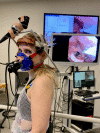Reliability of translaryngeal airway resistance measurements during maximal exercise
- PMID: 35309036
- PMCID: PMC8923134
- DOI: 10.1183/23120541.00581-2021
Reliability of translaryngeal airway resistance measurements during maximal exercise
Abstract
Objective: Exercise-induced laryngeal obstruction is an important cause of exertional dyspnoea. The diagnosis rests on visual judgement of relative changes of the laryngeal inlet during continuous laryngoscopy exercise (CLE) tests, but we lack objective measures that reflect functional consequences. We aimed to investigate repeatability and normal values of translaryngeal airway resistance measured at maximal intensity exercise.
Methods: 31 healthy nonsmokers without exercise-related breathing problems were recruited. Participants performed two CLE tests with verified positioning of two pressure sensors, one at the tip of the epiglottis (supraglottic) and one by the fifth tracheal ring (subglottic). Airway pressure and flow data were continuously collected breath-by-breath and used to calculate translaryngeal resistance at peak exercise. Laryngeal obstruction was assessed according to a standardised CLE score system.
Results: Data from 26 participants (16 females) with two successful tests and equal CLE scores on both test sessions were included in the translaryngeal resistance repeatability analyses. The coefficient of repeatability (CR) was 0.62 cmH2O·L-1·s-1, corresponding to a CR% of 21%. Mean±sd translaryngeal airway resistance (cmH2O·L-1·s-1) in participants with no laryngeal obstruction (n=15) was 2.88±0.50 in females and 2.18±0.50 in males. Higher CLE scores correlated with higher translaryngeal resistance in females (r=0.81, p<0.001).
Conclusions: This study establishes translaryngeal airway resistance obtained during exercise as a reliable parameter in respiratory medicine, opening the door for more informed treatment decisions and future research on the role of the larynx in health and disease.
Copyright ©The authors 2022.
Conflict of interest statement
Conflict of interest: Z. Fretheim-Kelly has nothing to disclose. Conflict of interest: M. Engan has nothing to disclose. Conflict of interest: H. Clemm declares unpaid roles as the leader of of the Bergen ILO group and chair of subgroup 6 on the upper airway in the IOC consensus of acute respiratory illness in athletes. Conflict of interest: T. Andersen declares funding for the present manuscript from Haukeland University Hospital, as well as research funding from the Western Norway Health Authority (grant number F-12564-D10550) in the 36 months prior to manuscript submission. Conflict of interest: J-H. Heimdal has nothing to disclose. Conflict of interest: E. Strand has nothing to disclose. Conflict of interest: T. Halvorsen declares funding for the present manuscript from Haukeland University Hospital and the University of Bergen, and research funding from the Western Norway Health Authority (grant number F-12564-D10550) in the 36 months prior to manuscript submission. Conflict of interest: O. Røksund declares funding for the present manuscript from Haukeland University Hospital and the Faculty of Health and Social Sciences, Bergen University College,a nd funding from the Western Norway Health Authority (grant number F-12564-D10550) in the 36 months prior to manuscript submission. Conflict of interest: M. Vollsæter declares unpaid fiduciary or leadership roles with WestPaed Research and Project Extreme Prematurity, and that they are a Board member of HelpILO.
Figures



References
LinkOut - more resources
Full Text Sources
